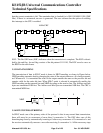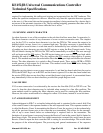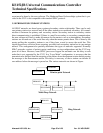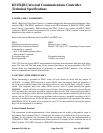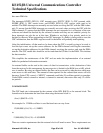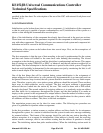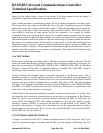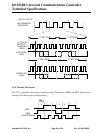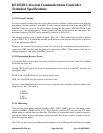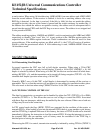
KS152JB Universal Communications Controller
Technical Specifications
Kawasaki LSI USA, Inc. Page 59 of 120 Ver. 0.9 KS152JB2
specified in the data sheet. For a description of the use of the GSC with external clock please read
Section 3.5.11.
3.5.5 INITIALIZATION
Initialization can be broken down into two major components, 1) initialization of the component
so that its serial port is capable of proper communication; and 2) initialization of the system or a
station so that intelligible communication can take place.
Most of the initialization of the component has already been discussed in the previous sections.
Those items not covered are the parameters required for the component to effectively communi-
cate with other components. These types of issues are common to both system and component ini-
tialization and will be covered in the following text.
Initialization of the system can be broken down into several steps. First, are the assumptions of
each network station.
The first assumption is that the type of data encoding to be used is predetermined for the system
and that each station will adhere to the same basic rules defining that encoding. The second
assumption is that the basic protocol and line discipline is predetermined and known. This means
that all stations are using CSMA/CD or SDLC or whatever, and that all stations are either full or
half duplex. The third assumption is that the baud rate is preset for the whole system. Though the
baud rate could probably be determined by the microprocessor just by monitoring the link, it will
make it much simpler if the baud rate is known in advance.
One of the first things that will be required during system initialization is the assignment of
unique addresses for each station. in a two-station only environment this is not necessary and can
be ignored. However, keep in mind, that all systems should be constructed for easy future expan-
sions. Therefore, even in only a two station system, addresses should be assigned. There are three
basic ways in which addresses can be assigned. The first, and most common is preassigned
addresses that are loaded into the station by the user. This could be done with a DIP-switch,
through a keyboard. The second method of assigning addresses is to randomly assign an address
and then check for its uniqueness throughout the system, and the third method is to make an
inquiry to the system for the assignment of a unique address. Once the method of address assign-
ment is determined, the method should become part of the specifications for the system to which
all additions will have to adhere. This, then, is the final assumption.
The negotiation process may not be clear for some readers. The following two procedure are
given as a guideline for dynamic address assignment.
In the first procedure, a station assumes a random address and then checks for its uniqueness
throughout the system. As a station is initialized into the system it sends out a message containing
its assumed address. The format of the message should be such that any station decoding the
address recognizes it as a request for initialization. if that address is already used, the receiving
station returns a message, with its own address starting that the address in question is already
taken. The initializing station then picks another address. When the initializing station sends its



